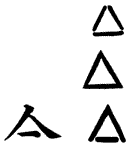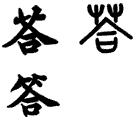Do Chinese Characters Tell
Us Something About Genesis?
Part 6 - The Tower of Babel
The Tower of Babel page is the fifth of five pages that attempt to
relate the forms of Chinese characters to ideas from the Book of
Genesis. Nelson
and Broadberry do not repeat any of this in Genesis and the Mystery
Confucius
Couldn't Solve.
The first character on the Tower of Babel page is tu3, with the modern meaning "dirt, earth".
This
character is not analyzed on this page, but is translated as "clay".
The second (and fourth) character on the Tower of Babel page is he2, with the modern meaning "unite;
together".
The authors interpret this character as being made up of "man", "one",
and
"person". According to Wieger, the upper portion of the character is as
follows:

Ji2. Notion of union, of assemblage, of a junction of different
elements,
represented by three lines. Three is used to mean many.

He2. Union, agreement, harmony. Etymologically, many (three)
mouths
speaking together; good understanding.
The third (and fifth) character on the Tower of Babel page is da2, which has a wide variety of modern
meanings,
including "to undertake". It is also the original form of the character
"to
answer". The authors interpret it as being composed of "unity" and
"weeds".
However, the original meaning of the character was not "to undertake".
This
is an extended meaning, as Wieger explains.

Da2. Vetch, pea, vegetables, whose boughs are joined, get
entangled. Extended meaning, to join, to adapt, to answer.
The sixth character on the Tower of Babel page is ta3, with the modern meaning "tower". The
authors
interpret it as "to undertake" and "clay", but the "to undertake"
portion
is simply the phonetic element.
Nelson and Broadberry no longer support any of the preceding
interpretations.
The seventh character on the Tower of Babel page is she2, with the modern meaning "tongue". The
authors
explain this as a compound of "mouth" and "thousand". Once again, they
fail
because they don't know the original forms of the characters involved.
Nelson
and Broadberry no longer support this interpretation.
Here are the originals for "thousand" and "tongue":

Qian1. A thousand; Ten times one hundred. The hundred is not
represented
in the character. The portion on the top, an abbreviation of ren2
(person)
is phonetic says the Glose.
Contrast the old form of qian1, above, with the supposedly
identical element in she2, below:

She2. The tongue stretched out of the mouth.
The eighth character on the Tower of Babel page is luan4, with the modern meaning "disorder,
confusion".
The authors say that it is composed of "tongue" and "(right)
leg".
Nelson and Broadberry no longer support this interpretation.
In fact, the character they give is a short form of the original,
which is shown below. (And Wieger says that the "(right) leg" actually
represents a thread being drawn out of a tangle.)

The ninth character on the Tower of Babel page is fen1, with the modern meaning "divide,
separate;
partake". The authors again take the upper element as meaning "eight",
but
it still means "to divide". Nelson and Broadberry no longer
support
this interpretation.

Fen1. To divide, to separate, to partake. A knife (dao1)
that
divides (ba1).
The Creation The Garden of Eden The Fall The Flood
Back to the Chinese Characters and Genesis
Home Page
 Languages Page
Languages Page
 Back to RaccoonBend.com Home
Page
Back to RaccoonBend.com Home
Page






![]()

![]() Back to RaccoonBend.com Home
Page
Back to RaccoonBend.com Home
Page